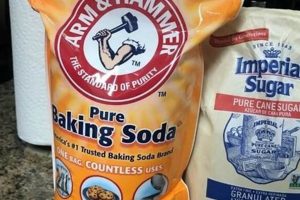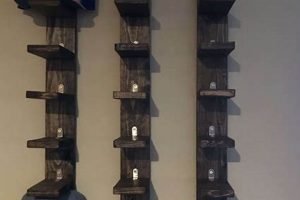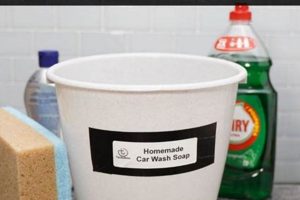The creation of decorative adhesives designed for application to glass surfaces, produced independently rather than purchased pre-made, allows for customization and personalization. These artistic applications, typically temporary in nature, adhere to windows, mirrors, or other smooth surfaces through static electricity or a mild adhesive, providing a means of ornamentation. An example includes the fabrication of festive decorations for seasonal holidays using readily available materials.
Self-made decorative applications offer an accessible avenue for artistic expression and resourcefulness. The practice can reduce reliance on mass-produced items, fostering creativity and individual design aesthetics. Historically, similar techniques involving homemade adhesives and pigments were used for temporary displays and announcements, demonstrating a long-standing interest in easily removable window ornamentation. Furthermore, it benefits people by offering a creative outlet and a cost-effective decorating solution.
The subsequent sections will detail specific techniques, material considerations, and design principles pertinent to the effective construction and application of self-created window decorations. Detailed instructions and safety precautions will also be provided to ensure successful project outcomes.
Essential Production Guidance
The following recommendations aim to optimize the creation process, ensuring durable and visually appealing outcomes for self-adhesive window decorations.
Tip 1: Material Selection: Opt for non-toxic, pliable materials such as polyvinyl acetate (PVA) glue or specialized window cling mediums. Prioritize materials compatible with glass surfaces to prevent damage or residue upon removal.
Tip 2: Surface Preparation: Thoroughly clean the intended application surface with a non-abrasive cleaner and allow it to dry completely. This ensures optimal adhesion and prevents air bubbles during application.
Tip 3: Template Utilization: Employ stencils or printed templates to achieve precise designs. Secure the template beneath a non-stick surface before applying the adhesive medium.
Tip 4: Layering Technique: Apply the adhesive medium in thin, even layers, allowing each layer to dry completely before adding subsequent layers. This prevents warping and ensures structural integrity.
Tip 5: Color Integration: Incorporate food coloring or specialized pigment concentrates to achieve desired hues. Blend colors thoroughly to prevent streaking or uneven distribution.
Tip 6: Drying Process: Allow the finished product to dry completely on a flat, non-stick surface for a minimum of 24 hours. Adequate drying time prevents distortion and ensures ease of removal.
Tip 7: Storage Considerations: Store completed decorations flat, between sheets of parchment paper, to prevent sticking and maintain their shape until use.
Adhering to these guidelines promotes the longevity and visual appeal of these homemade decorations, enhancing their utility as decorative elements.
The concluding section will address advanced techniques and creative applications for these personalized window adornments.
1. Material Pliability
Material pliability, or the capacity of a substance to deform under stress without fracturing, is a critical determinant in the feasibility and aesthetic quality of self-made window decorations. The inherent flexibility of the chosen medium dictates the intricacy of designs achievable and the ease with which the decoration conforms to the window surface.
- Conformity to Surface Irregularities
Higher pliability allows the finished product to adhere more effectively to minor imperfections or curves present in the glass surface. A less pliable material is more prone to detaching at edges or creating air pockets, compromising the overall adhesion and visual integrity. Consider the application surface when selecting a material.
- Intricacy of Design Detailing
Pliable materials accommodate finer design elements and sharper corners without tearing or losing shape during the curing or removal processes. Materials with limited pliability might be better suited for simpler, more geometric designs to avoid structural failures. For example, intricate patterns, such as snowflakes with delicate branches, demand a highly flexible medium.
- Durability Under Temperature Fluctuations
Materials with good pliability are better able to withstand expansion and contraction caused by temperature changes without cracking or distorting. This is especially important for window decorations exposed to direct sunlight or significant temperature variations. Decorations made from less pliable materials may become brittle and prone to damage over time.
- Ease of Removal and Repositioning
A pliable material generally allows for cleaner and easier removal from the glass surface, minimizing the risk of residue or damage. Furthermore, pliability facilitates gentle repositioning of the decoration should initial placement require adjustment, leading to more satisfactory results. For example, decorations made of extremely rigid material can shatter during removal.
In summary, material pliability significantly influences the artistic potential and practical durability of independently produced window decorations. Choosing materials that possess adequate flexibility is vital for ensuring satisfactory adhesion, intricate detailing, resistance to environmental factors, and effortless removal, all of which contribute to the overall success of the decorating project.
2. Adhesive Strength
Adhesive strength constitutes a fundamental property determining the functionality and longevity of self-made window applications. This characteristic defines the force required to detach the decorative element from the glass substrate. In the context of independently produced applications, adhesive strength dictates the decoration’s capacity to remain affixed under varying environmental conditions, including temperature fluctuations and humidity levels. Insufficient adhesive strength precipitates premature detachment, negating the intended aesthetic purpose. For instance, a window decoration crafted with diluted glue may exhibit inadequate adhesion, leading to its dislodgement shortly after application.
Optimal adhesive strength is achieved through the careful selection and application of appropriate bonding agents. Factors such as the type of adhesive used, the surface preparation of the glass, and the ambient temperature during application significantly influence the ultimate bond strength. The application of a thin, even layer of adhesive maximizes contact surface area and promotes uniform distribution of stress. Conversely, excessive adhesive can lead to unsightly residue upon removal or
compromise the clarity of the decoration. For example, decorations using a homemade mixture of gelatin and corn syrup may exhibit satisfactory initial adhesion but degrade over time due to humidity absorption. The appropriate choice of material can prevent such failures.
In summary, the adhesive strength of self-made window applications is a critical performance parameter directly influencing their effectiveness and durability. Careful consideration of material selection, surface preparation, and application technique is essential to achieve optimal adhesion. A balance must be achieved between adequate bond strength for secure attachment and ease of removal to prevent damage to the underlying glass surface. Failing to account for these factors undermines the utility and aesthetic value of these homemade decorations.
3. Design Complexity
Design complexity, in the context of self-created window ornamentation, refers to the level of intricacy and detail involved in the creation and execution of a particular decorative motif. It encompasses considerations regarding the number of elements, the fineness of lines, the layering of colors, and the overall technical skill required to produce a visually compelling and structurally sound window decoration.
- Intricacy of Patterns and Shapes
The intricacy of patterns directly impacts the feasibility of execution. Decorations featuring elaborate geometric designs or detailed representational images necessitate greater precision in cutting, layering, and application. A simple, minimalist design, such as a solid-color star, presents a significantly lower degree of complexity than a multi-colored stained-glass effect requiring careful alignment and blending of hues. The selection of designs needs to be suitable for people from beginner to expert level.
- Number of Discrete Elements
The quantity of individual pieces or components composing the decoration influences the time investment and technical challenge involved. A design consisting of numerous small, separate elements requires painstaking assembly and precise placement to achieve a cohesive and visually balanced final product. For example, creating a complex mosaic-like pattern with individual colored squares would be considerably more demanding than producing a single, unified shape.
- Layering and Depth
Designs that incorporate layering techniques to create depth or three-dimensional effects introduce an additional level of complexity. Layering necessitates meticulous planning and execution to ensure proper alignment and avoid distortion or bubbling. The successful creation of a layered effect requires not only technical skill but also an understanding of color theory and visual perspective. The process of having shadows and effects is the biggest challenge of design.
- Color Palette and Blending
The range of colors employed in a design and the extent to which they are blended or gradated affect the perceived complexity. Designs utilizing a limited color palette and simple color blocking are inherently less complex than those incorporating numerous hues and subtle blending techniques. Achieving smooth gradients and nuanced color transitions demands skill and precision, adding to the overall difficulty of the project. For instance, a sunrise effect with gradual transitions from orange to yellow to pink requires considerably more artistry than a simple rainbow design.
In conclusion, design complexity significantly impacts the accessibility and achievable outcomes of DIY window decoration projects. Novice creators may benefit from starting with simpler designs featuring basic shapes and limited color palettes, gradually progressing to more intricate and challenging projects as their skills develop. The selection of an appropriate design complexity should align with the individual’s technical proficiency and the desired aesthetic effect, thereby maximizing the potential for a successful and satisfying decorative outcome.
4. Surface compatibility
Surface compatibility is paramount to the successful application and subsequent removal of self-made window decorations. The interaction between the adhesive material of the application and the chemical composition of the window glass determines the efficacy and safety of the decorative element. Incompatibility can manifest in several adverse outcomes, including impaired adhesion, chemical etching of the glass surface, or the deposition of intractable residues. The choice of materials for “diy window clings” must therefore consider the specific properties of the intended substrate to mitigate potential damage and ensure easy removal. For example, certain types of acrylic adhesives can react adversely with coated window films, leading to discoloration or delamination of the film.
Practical application necessitates a thorough understanding of the potential interactions between the decoration’s constituent materials and the window surface. The use of non-toxic, pH-neutral adhesives is generally recommended to minimize the risk of chemical reactions. Prior testing on an inconspicuous area of the window is advisable, especially when utilizing unconventional or homemade adhesive formulations. Furthermore, the application environment should be controlled to avoid extremes of temperature or humidity, which can exacerbate incompatibility issues. For instance, applying a decoration during high humidity can trap moisture between the adhesive and the glass, potentially leading to mold growth or weakened adhesion over time.
In conclusion, surface compatibility is a critical determinant of the long-term viability and safety of self-made window decorations. A comprehensive understanding of the materials involved, coupled with careful testing and controlled application practices, is essential to prevent damage to the glass surface and ensure the easy removal of the decoration. Overlooking this aspect can result in costly repairs or irreversible aesthetic damage, underscoring the significance of prioritizing compatibility considerations in all stages of the decorative process.
5. Removal ease
The property of easy removal is a critical attribute directly influencing the appeal and practicality of self-constructed window applications. The ability to remove a decorative application without leaving residue, damaging the glass, or requiring excessive effort is paramount to its successful implementation. Difficulty in removing a window application can lead to frustration, necessitate extensive cleaning, and potentially cause irreversible harm to the underlying glass surface. The selection of materials and the application technique employed significantly affect the ultimate ease of removal. For example, an application made with a high-tack adhesive may adhere strongly but prove exceedingly difficult to remove cleanly, leaving behind a persistent sticky residue. Therefore, for successful applications, the decorations must be removed without stress.
Several factors contribute to achieving satisfactory removal. The use of non-permanent adhesive agents designed for temporary applications is essential. Furthermore, proper surface preparation, involving thorough cleani
ng of the glass before application, minimizes the risk of adhesion irregularities and residue formation. Environmental conditions during application, such as temperature and humidity, can also influence removal ease. An application applied in high humidity may exhibit increased adhesion due to moisture trapping, making removal more challenging. Consider the composition of the adhesive to prevent long-term degradation or bonding that complicates detachment. For example, natural adhesives may harden over time, losing their flexibility and making them more likely to break apart during removal.
In conclusion, the ease of removal is an indispensable characteristic of self-made window ornamentation. Careful consideration of adhesive selection, surface preparation, and environmental factors is necessary to ensure that the decorative application can be removed cleanly and efficiently, without compromising the integrity of the underlying glass surface. Prioritizing removal ease enhances the overall user experience and contributes to the long-term viability of self-made window decorating as a practical and aesthetically pleasing practice.
Frequently Asked Questions Regarding Self-Made Window Decorations
The following section addresses common inquiries and concerns regarding the creation and application of independently produced decorative elements for glass surfaces. The information presented aims to provide clarity and guidance for individuals engaging in this artistic endeavor.
Question 1: What adhesive materials are most suitable for window applications while ensuring easy removal and preventing damage to the glass?
Polyvinyl acetate (PVA) glues and specialized window cling mediums are generally recommended. These materials offer a balance between adhesion strength and removability, minimizing the risk of residue or surface damage.
Question 2: How can one prevent the formation of air bubbles during the application process?
Thoroughly cleaning the glass surface prior to application is crucial. Applying the adhesive medium in thin, even layers and using a squeegee or similar tool to gently press out any trapped air also helps minimize bubble formation.
Question 3: What techniques can be employed to create multi-colored or layered designs?
Layering techniques involve applying the adhesive medium in sequential layers, allowing each layer to dry completely before adding subsequent colors or design elements. Stencils or templates can aid in achieving precise alignment and color separation.
Question 4: How does temperature and humidity affect the adhesion and longevity of the window decorations?
Extreme temperatures and high humidity can compromise the adhesive properties of the decorative element. Application during moderate weather conditions is recommended. Avoiding direct sunlight exposure can prolong the lifespan of the decoration.
Question 5: What is the recommended procedure for cleaning windows with self-made decorations?
Gentle cleaning with a soft cloth and mild, non-abrasive cleaning solutions is advised. Avoid harsh chemicals or scrubbing, which can damage the decoration or the underlying glass surface.
Question 6: How should completed decorations be stored to prevent sticking or damage?
Completed decorations should be stored flat, between sheets of parchment paper or non-stick release liners, in a cool, dry place. This prevents sticking and helps maintain their shape until use.
These responses provide a foundational understanding of key considerations for creating and maintaining self-made window applications. Adherence to these guidelines promotes successful project outcomes and ensures the longevity of the decorative elements.
The subsequent section will explore advanced techniques and creative variations for these personalized window adornments.
Concluding Remarks on DIY Window Clings
This exploration of “diy window clings” has illuminated critical aspects concerning material selection, design complexity, adhesive properties, surface compatibility, and removal ease. Through careful consideration of these factors, individuals can effectively create customized decorative elements for glass surfaces. The process allows for individual expression while potentially reducing reliance on commercially manufactured alternatives.
The practice of crafting “diy window clings” offers tangible benefits in terms of creative outlet and personalized aesthetics. Further investigation into advanced techniques and sustainable material alternatives can enhance both the artistic potential and environmental responsibility associated with this decorative art form. Continued refinement of techniques may lead to greater durability and wider applicability of these homemade decorations.







